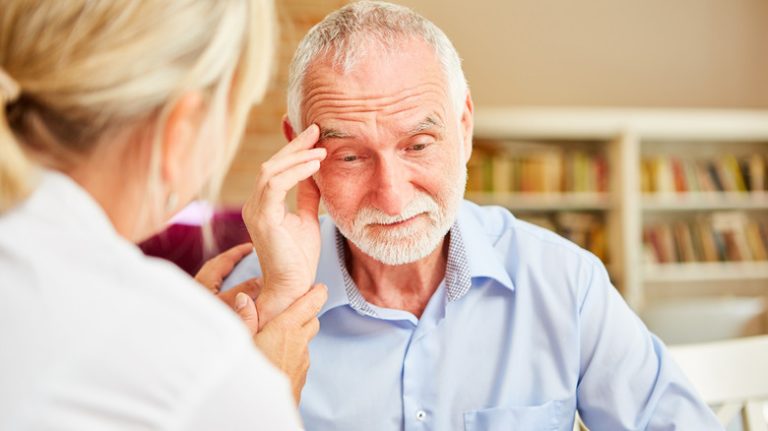According to a 2024 study in Clinical Psychopharmacology and Neuroscience, a panic attack is a sudden outbreak of extreme fear or distress that peaks within 10 minutes and can last for several moments. It can happen unexpectedly, and can be a symptom of panic disorder, a type of anxiety disorder characterized by recurrent panic attacks that are followed by a month of endless worry about the likelihood of having more attacks.
A panic attack can be a frightening and overwhelming experience for those who endure it, and it can negatively affect multiple aspects of a person’s daily life. Per the Anxiety and Depression Association of America (ADAA), roughly 2 to 3% of Americans face spontaneous panic attacks as part of their panic disorder diagnosis, and while it may also affect younger children, it mostly happens to adults over 20 years old (and they seem to be more common in women compared to men). Per the Cleveland Clinic, there is still no known cause for panic attacks, yet experts believe your nervous system plays an essential role. In fact, the previously mentioned study explains that if the nervous system does play a key role, then panic attacks most likely have a greater impact on people with a dysfunctional fear network (or those who can’t properly manage fear and anxiety).
Understanding the cause of panic attacks can significantly help with early detection and treatment, and while the cause may be unknown, identifying what may trigger your attacks can also help improve your quality of life.
Signs and symptoms of a panic attack
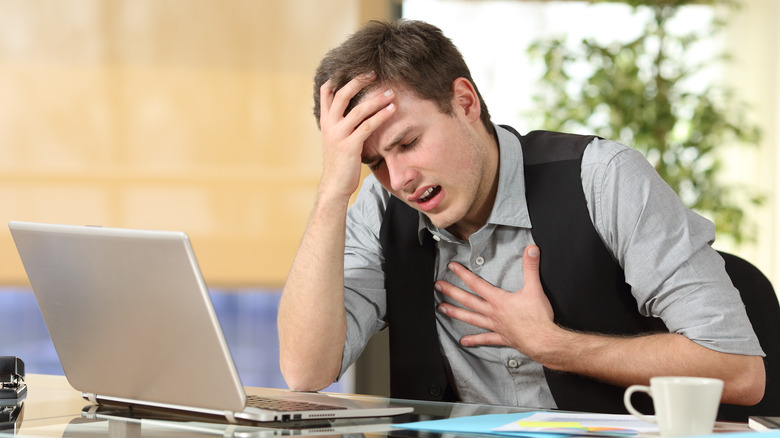
Due to their wide variety of symptoms, panic attacks can look different for everybody. However, a 2024 study in Clinical Psychopharmacology and Neuroscience explains that, for the most part, they can be rounded up into two different categories: physical (or somatic) and cognitive or mental. On the one hand, physical panic attack symptoms are the tangible ones you (and sometimes others) can perceive through your senses. They include pounding or accelerated heartbeat, sweating, shaking or trembling, shortness of breath or a feeling of choking or smothering, chest pain, nausea, abdominal pain, headache, dizziness or lightheadedness, and chills or hot flashes.
On the other hand, cognitive symptoms are the ones that relate to your mind or brain and, thus, are perceived almost exclusively by yourself or the person having the attack. Such symptoms include derealization or the feeling of unreality or detachment from the present moment, depersonalization or feeling detached from oneself, fear of losing control or going crazy, fear of dying or a sense of upcoming danger, and paresthesia or feeling numbness or a tingling sensation.
Lastly, the Mayo Clinic adds that symptoms of a panic attack can appear almost out of the blue or when you’re least expecting them, even in your sleep. Plus, while the symptoms themselves are not harmful, they may put you in danger if they occur while you’re performing certain daily activities, such as driving — which is why getting medical help is so important.
Phobia-related triggers
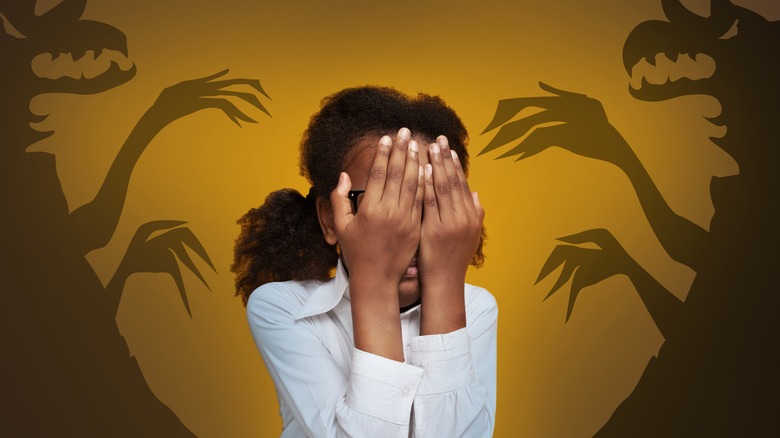
Seeing that a panic attack is a manifestation of extreme fear, it is no surprise that phobias are potential triggers. According to Medical News Today, like panic attacks, phobias are an anxiety disorder. However, these are characterized by an intense and persistent fear of a specific object, situation, or activity that is generally not dangerous or threatening. Still, they can lead to panic attacks in those who experience them. Per the site, the American Psychiatric Association divides phobias into three groups, including specific phobias, social phobias, and agoraphobia. Specific phobias are easier to identify because they link to a particular trigger, and are thus known as simple phobias. In contrast, the remaining two, which reflect the fear of social gatherings and the fear of hard-to-escape situations, respectively, are known as complex phobias because of the broad nature of their triggers.
Simple phobias are very common in the U.S., affecting roughly 19 million adults, and they’re characterized by fear, anxiety, and avoidance, all of which can end up in a full-blown panic attack (via PsychCentral). In fact, their symptoms are very similar, as they also cause physical and cognitive signs such as rapid heartbeat, sweating, dizziness, and a sense of danger, discomfort, and depersonalization. Per Medical News Today, some of the most common simple phobias include a fear of being in small or confined spaces (claustrophobia), flying (aerophobia), vomiting (emetophobia), spiders (arachnophobia), animals (zoophobia), and heights (acrophobia).
Going through a traumatic event
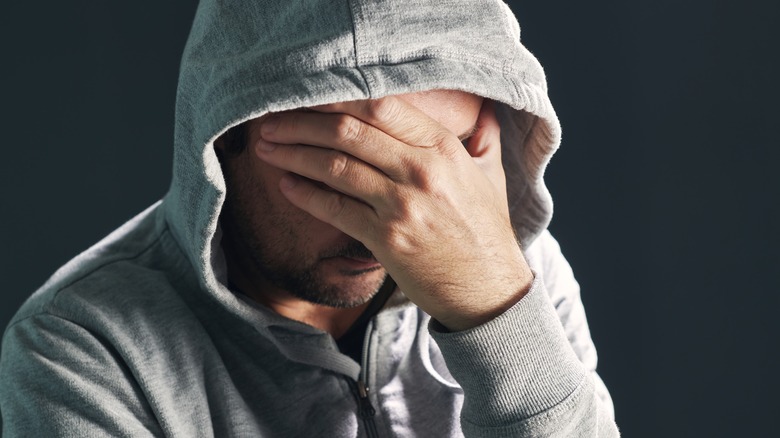
Bits And Splits/Shutterstock
The American Psychological Association describes trauma as an emotional response to a deeply distressing or disturbing experience, such as a car accident, combat, physical or sexual assault, or natural disaster, that affects a person’s ability to cope in the short and long run and can potentially lead to unpredictable emotions and physical manifestations. As the Panic and Anxiety Community Support (PACS) explains, trauma impacts your brain activity by affecting the amygdala, hippocampus, and prefrontal cortex regions of your brain, which are associated with processing fear, memories and emotions, and cognitive or mental behaviors, respectively.
Per PACS, trauma and panic attacks are deeply intertwined. This is because the changes in your brain activity after a traumatic event can trigger panic attacks in the future, just as going through a panic attack can become a traumatic experience that increases the fear of future attacks. Moreover, trauma can cause a person to avoid situations, people, or activities that they associate with the traumatic event, which can lead to increased anxiety and trigger panic attacks when exposed to the traumatic trigger. Still, PsychCentral warns not to confuse trauma-induced panic attacks with post-traumatic stress disorder (PTSD). While going through a traumatic event is often associated with PTSD, not everyone who experiences trauma develops it. However, since PTSD is a dissociative disorder, it can sometimes be confused with panic disorder due to the similarity of their symptoms, such as the feeling of detachment.
Participating in social events

Fizkes/Shutterstock
For some people, participating in social events can trigger a panic attack, which is caused by an ongoing fear of being exposed to people they don’t know, as well as the possibility of being scrutinized or humiliated by others. According to the National Institute of Mental Health, this is known as Social Anxiety Disorder (SAD) or social phobia, and it affects about 7% of the U.S. adult population. Per a 2024 study published in the Journal of Affective Disorders, SAD is an anxiety disorder that’s frequently linked to panic attacks. However, unlike panic attacks from a panic disorder (which are sudden and unexpected), these are triggered by feared social situations and, thus, are expected or linked to specific known circumstances, such as public speaking or attending an event.
Per anxiety.org, people with panic attacks triggered by social anxiety have an increased fear of social situations and, therefore, become more impaired by their disorder as they will put a greater effort into avoiding such scenarios. They also tend to turn to unhealthy habits to cope with their fear, such as alcohol use or illicit drug intake. Lastly, per the site, the combination of social anxiety and panic attacks also seems to increase the likelihood of developing other psychiatric disorders, unlike people who only have social anxiety without panic attacks.
Substance abuse

Giselleflissak/Getty Images
According to the Anxiety and Depression Association of America (ADAA), substance abuse can make anxiety symptoms worse, and in people with panic attacks, the stakes seem to be higher. Alcohol and drug use can not only increase the likelihood of having a panic attack, but their intake also increases the risk of developing a substance abuse disorder or addiction. In fact, per the American Addiction Centers (AAC), about 20% of people with panic disorder are also diagnosed with a substance abuse disorder. This often happens because people who constantly have panic attacks tend to self-medicate with alcohol, tobacco, marijuana, and stimulant drugs to cope with their attacks. Moreover, per the AAC’s National Rehabs Directory, withdrawal symptoms from quitting alcohol or marijuana can also trigger panic attacks due to increased anxiety levels.
If you struggle with substance abuse and are experiencing panic attacks, it is important to seek professional help. According to the AAC, people diagnosed with both panic and substance abuse disorders should get individual yet simultaneous treatment for both conditions to ensure their safety and a successful recovery.
If you or anyone you know needs help with addiction issues, help is available. Visit the Substance Abuse and Mental Health Services Administration website or contact SAMHSA’s National Helpline at 1-800-662-HELP (4357).
Stressful situations
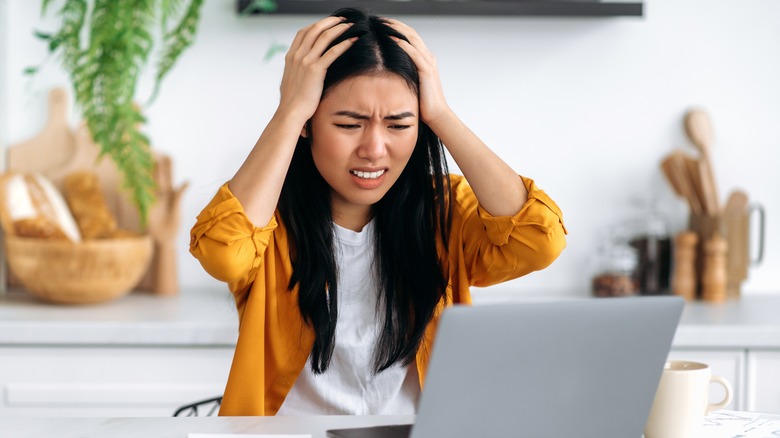
Kateryna Onyshchuk/Shutterstock
Going through significant life situations that are often connected to a negative outcome, such as losing your job, a divorce, a disease diagnosis, or the death of a family member, are considered risk factors for severe and potentially chronic stress which, in turn, is also a potential trigger of panic attacks (via StressTalk.net).
Per a 2024 study published in SAGE Journals, animal studies show that stress can have a detrimental effect on the brain’s chemistry, which leads to an increased risk of fear and anxiety disorders that researchers believe resemble the effects of stress on different pathways of the human nervous system. In addition, the study reports the results of a clinical trial in which the course of panic disorder and its response to treatment were worsened due to chronic stress.
According to Healthline, recognizing your stressors is the first step toward managing your chronic stress. Moreover, the site recommends trying healthy coping strategies, such as getting a massage, exercising, doing yoga or tai chi, relaxation or breathing techniques, acupuncture, meditation, or seeking support from loved ones or a mental health professional to help you deal with your emotions when you’re feeling overwhelmed and prevent a potential panic attack. Note that while not all stress leads to a panic attack, it can still have a negative effect on your health.
Dealing with financial uncertainty
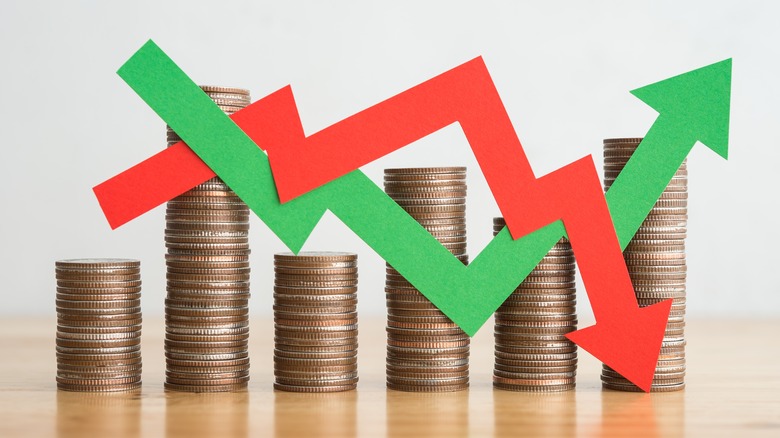
Pla2na/Shutterstock
Worrying about money can cause significant stress in your life, and such stress can easily trigger panic attacks. There are numerous causes that can lead to financial uncertainty or instability, including unemployment, debt, unexpected expenses, and even life events that are out of your control, such as economic crises. Still, regardless of the cause, financial uncertainty can lead to concerns about how to pay bills or meet basic needs such as food and housing, and these worries can cause a person to feel overwhelmed, helpless, and out of control, which can trigger a panic attack as well as multiple additional adverse health effects (per HelpGuide.org).
As the author of “The Money Anxiety Cure,” Koorosh Ostowari, explains via Healthline, feeling like you won’t make it to the end of the month creates an enormous fear that generates a physical response that resembles that of an animal’s defense mode while hunting. Thus, it is no surprise that this is a potential trigger for panic attacks. However, HelpGuide.org explains that you can implement some strategies to help you cope with your money concerns, such as reaching out for help, staying on top of your finances instead of avoiding or denying your reality, creating a budget (and sticking to it!) to keep track of your expenses, avoiding impulse or emotional spending, and practicing gratitude.
Preexisting conditions or medication side effects
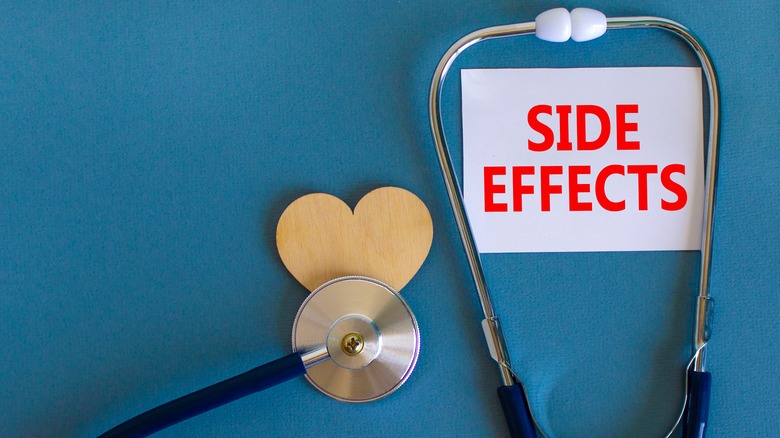
Dmitry Demidovich/Shutterstock
The National Library of Medicine (NIH) states that panic attacks can also come from the direct effects of preexisting medical conditions or as a result of a medication’s side effects. One such medical condition that is directly linked to panic attacks is hyperthyroidism (a condition in which your thyroid gland produces too much thyroid hormone). As CalmClinic explains, panic attacks derived from hyperthyroidism are very similar to anxiety-induced ones in that they both may happen unexpectedly. This is because having an overactive thyroid gland can increase symptoms of anxiety as well as impact your brain’s chemistry, which results in panic attack-like symptoms like nervousness, shakiness, and increased heartbeat, which may ultimately trigger an attack.
As for medication’s side effects, asthma and seizure drugs are two common medicines known to increase the risk of panic attacks (per WebMD). Asthma medications such as albuterol (Proventil) and salmeterol (Serevent Diskus) can cause anxiety and other side effects that highly resemble panic attacks. The same goes for the seizure medication phenytoin (Dilantin and Phenytek). If you have a preexisting condition or are taking medication that increases the risk of panic attacks, it is important to speak with your healthcare provider, who may be able to adjust your medication or recommend additional treatments to manage your symptoms.
Following an unhealthy diet

Julia Sudnitskaya/Shutterstock
“Let food be thy medicine, and let medicine be thy food” is a famous quote believed to be said by the Ancient Greek physician Hippocrates, and while some question its origin, it does have some truth to it, at least when it comes to panic attacks.
According to a 2024 study in Acta Medica Okayama, panic attacks can be triggered by low serotonin levels (a chemical messenger within your brain whose main function is to manage your mood). Serotonin is produced from the amino acid tryptophan. However, tryptophan metabolism is directly affected by vitamin B6 levels (via a review in Advances in Nutrition). This means that low levels of this vitamin would hinder the production of serotonin. Similarly, low iron levels could also lead to low serotonin levels, which, in consequence, could trigger panic attacks. In fact, per the study, people who experience panic attacks tend to have significantly lower vitamin B6 and iron levels compared to controls. Therefore, following an unhealthy diet can directly impact your chances of having a panic attack.
To prevent this from happening, be sure to add vitamin B6, iron, and tryptophan-rich foods to your diet. Sources of vitamin B6 include bananas, milk, chickpeas, spinach, sweet potatoes, salmon, tuna, eggs, and carrots (via Healthline). As for iron-rich foods, some include animal-based proteins, lentils, tofu, whole grains, and dark leafy greens (per the Cleveland Clinic). Lastly, dietary sources of tryptophan include turkey, chicken, oats, cheese, chocolate, nuts and seeds, and bread.
Sensitivity to caffeine

Andrey_Popov/Shutterstock
Stimulants are substances that boost the activity of your central nervous system, and caffeine is one of the most widely used stimulants worldwide due to its effect on energy levels (via the National Library of Medicine (NIH)). It is naturally present in certain drinks and foods like coffee, tea, and chocolate. Yet, it is also added to energy drinks and sodas, which explains its high intake around the world. While some can’t seem to start their days without their caffeine fix, those with panic disorder are advised to avoid its consumption altogether, as it has been shown to have panic-inducing properties.
According to a 2024 review published in the journal General Hospital Psychiatry, 51% of the 237 people across 9 different studies had a panic attack following caffeine intake. The effect was attributed to an increased sensitivity to the anxiety-causing effects of caffeine. In fact, the review concluded that an amount equal to drinking five cups of coffee could induce panic attacks in people with panic disorder. Yet the amount of caffeine that triggers a panic attack can vary from person to person. Thus, If you are susceptible to panic attacks, it is important to monitor your caffeine intake and limit it if necessary.
Having catastrophic thoughts
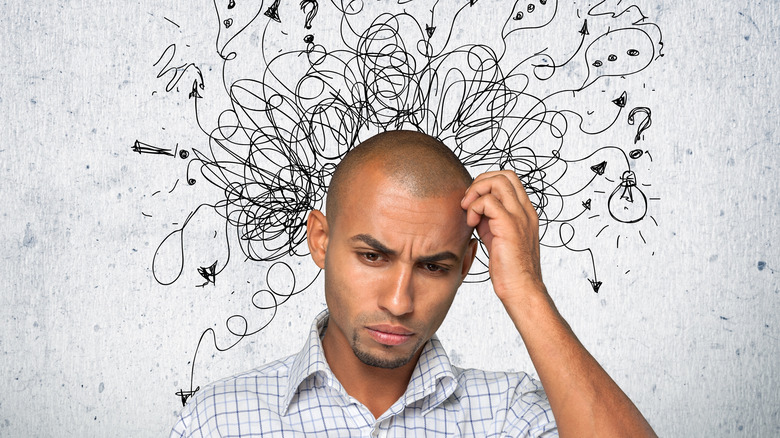
Billion Photos/Shutterstock
Per the American Psychological Association (APA), having catastrophic thoughts or catastrophizing is when a particular circumstance or situation leads you to think about the worse possible scenario or when any upsetting situation makes you feel as if you were experiencing a tragedy or disaster, which leads to high anxiety levels that can potentially trigger a panic attack due to the perceived threat or stress. According to PsychCentral, catastrophizing can escalate quickly from a small thought that you overthink until you spiral out of control, and it often occurs when you feel anxious or depressed, have racing thoughts, or have overwhelming feelings of anger or fear.
Moreover, Psychology Today explains that people who constantly have panic attacks tend to become hypervigilant about the symptoms of an attack because of their fear of feeling like they’re dying. As you can imagine, this often leads to higher anxiety levels, which increases the chances of going through an actual panic attack. In these cases, the site recommends acknowledging the feeling of panic instead of fighting it and remembering that an attack is only temporary.
Panic attack treatment options

Pormezz/Shutterstock
Panic attacks can be treated through either psychotherapy, medication, or a combination of the two, depending on your personal choice and the severity and frequency of your attacks (via the Mayo Clinic). Psychotherapy (or talk therapy) is a form of treatment that involves working with a health professional to identify and address the causes of your panic attacks. There are several different types of psychotherapy that may be helpful in treating panic attacks, including cognitive-behavioral therapy (CBT) and exposure therapy, which involves exposure to the feared situation or object in a controlled environment to help desensitize you to the triggers that cause the panic attacks.
Panic attack medications mostly help manage symptoms. Antidepressant medications, such as selective serotonin reuptake inhibitors (SSRIs) and serotonin-norepinephrine reuptake inhibitors (SNRIs), can be effective in reducing the frequency and severity of panic attacks. Benzodiazepines, which are a type of sedative, can also be used to provide short-term relief of panic symptoms. Plus, remember that medication should only be used under the guidance of a qualified medical professional, as they can have potential side effects and risks.
If you or someone you know needs help with mental health, please contact the Crisis Text Line by texting HOME to 741741, call the National Alliance on Mental Illness helpline at 1-800-950-NAMI (6264), or visit the National Institute of Mental Health website.


